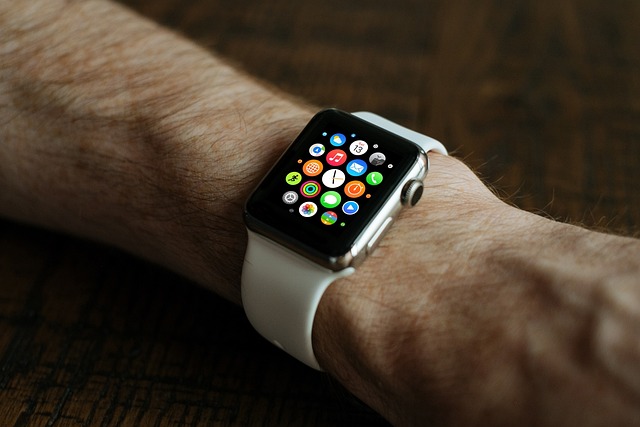To maintain optimal performance and longevity of your Apple Watch, it's crucial to regularly monitor its battery health. Use the built-in settings to track which apps consume the most power and adjust accordingly. The MyWatch app can alert you to significant battery changes and help you understand usage patterns that affect battery life. Software updates from Apple are key to improving battery performance and should be kept current. If you notice consistent battery drain or a sharp decline in charge retention, it's advisable to consider replacing the Apple Watch battery, which can be done safely and efficiently by professional services. Factors like heavy usage of features like heart rate monitoring and GPS, as well as environmental conditions, can influence battery longevity. Regular maintenance, such as charging when the battery level drops below 30%, using the official charger, and updating software, can help manage energy use and potentially extend battery life. Additionally, humidity and temperature extremes can affect battery performance, so it's important to protect your device from these elements. To ensure continued reliability of your Apple Watch, consider replacing its battery as part of routine care, which can be done by authorized service providers like the Genius Bar or through expert technicians. Regular updates and proactive management of settings can enhance battery efficiency, but when issues arise, professional replacement services are available to restore your watch's functionality.
When it comes to maintaining the longevity of your Apple Watch, understanding how to effectively manage its battery life is key. This comprehensive guide delves into the nuances of battery health indicators and provides actionable tips for optimizing your device’s charge cycles. We explore the factors that influence battery replacement frequency, the impact of charging habits, and the role of software updates in maintaining peak performance. From environmental conditions to professional versus DIY battery replacement options, this article covers it all, ensuring you’re equipped to make informed decisions about your Apple Watch’s battery health. Learn about cost-benefit analyses for replacements, life extension techniques, and the importance of warranty coverage. Whether you’re a tech enthusiast or an everyday user, these insights will help you extend the life of your Apple Watch battery and keep it running efficiently.
- Understanding Battery Health Indicators in Apple Watches
- Factors Affecting Battery Replacement Frequency for Apple Watches
- The Impact of Charging Habits on Apple Watch Battery Lifespan
- Tips to Optimize Charge Cycles and Prolong Your Apple Watch's Battery Life
- The Role of Software Updates in Managing Apple Watch Battery Performance
- How Environmental Conditions Influence Battery Durability in Apple Watches
- Strategies for Effective Energy Management on Your Apple Watch
Understanding Battery Health Indicators in Apple Watches

Monitoring the health of your Apple Watch’s battery is crucial for optimizing its performance and determining the right time to replace the battery if necessary. The Apple Watch is equipped with several health indicators that can help you gauge its battery life efficiency. These indicators include the battery usage settings, which provide detailed information on which applications are draining power most, allowing you to make informed adjustments to extend battery life. Additionally, the MyWatch app on your iPhone offers insights into battery levels over time and alerts you when a significant change occurs, indicating potential battery health issues. Regular software updates from Apple can also improve battery performance and longevity, ensuring that your device operates at peak efficiency. If you notice consistent battery drains or if your Apple Watch is no longer holding a charge as it once did, it may be time to consider replacing the battery. Professional services specializing in Apple devices can perform this replacement, typically within an hour, and at a fraction of the cost of a new watch. This service not only revitalizes your device but also offers a fresh battery that aligns with Apple’s safety standards, providing you with a reliable companion for health tracking and daily activities.
Factors Affecting Battery Replacement Frequency for Apple Watches

The frequency at which an Apple Watch battery requires replacement is influenced by several factors, each playing a pivotal role in the device’s longevity. Chief among these is usage patterns; frequent use, particularly with features that drain power such as continuous heart rate monitoring or GPS, can expedite battery degradation. The model of the Apple Watch also impacts its battery lifespan, with newer models often boasting improved energy efficiency. Environmental conditions, including extreme temperatures and humidity, can affect battery performance over time. It’s crucial for users to replace their Apple Watch batteries as needed to maintain optimal functionality and performance. Regular software updates from Apple can either enhance or diminish the efficiency of your battery, depending on how well the update manages power consumption. Additionally, user behavior, such as brightness settings, app usage, and notification preferences, significantly influences how long the battery lasts before replacement becomes necessary. To extend the life of an Apple Watch battery, consider adhering to recommended charging practices, avoiding full depletion of the battery, and keeping the device’s software up to date. These strategies can help manage energy use effectively, delaying the need for a battery replacement and ensuring your Apple Watch remains a reliable companion.
The Impact of Charging Habits on Apple Watch Battery Lifespan

Regular charging habits can significantly influence the longevity of your Apple Watch’s battery. To maximize the lifespan of your device, it’s advisable to avoid letting the battery fully deplete frequently. Doing so can put additional stress on the battery cells, leading to a shorter overall lifespan and potentially necessitating an earlier replacement of the Apple Watch battery. Instead, Apple recommends charging your watch when it drops below 30%, keeping it within a range that minimizes the need for the battery to undergo strenuous charging cycles from very low levels.
Moreover, optimal charging practices include using the official MagSafe charger or the Apple Watch charger whenever possible, as these are designed to work best with the device and can help prevent unnecessary strain on the battery. Additionally, keeping your Apple Watch software up-to-date not only ensures you have the latest features and security updates but also improves battery efficiency, which contributes to a longer battery life. If you notice a decline in battery performance or if your watch requires frequent charging, it may be time to consider replacing the Apple Watch battery. Professional repair services can assess the situation and perform a replacement efficiently, allowing you to extend the use of your trusted companion without compromising on its functionality.
Tips to Optimize Charge Cycles and Prolong Your Apple Watch's Battery Life

Regular software updates can significantly contribute to your Apple Watch’s battery efficiency. Ensuring your watch is running the latest version helps optimize background processes and reduces unnecessary drain. Additionally, managing notifications can prevent constant awakenings of the display, which are known to shorten charge cycles. Customize your notification settings to allow only critical alerts to come through while your watch is on your wrist, thus preserving battery life between charges.
To further extend the lifespan of your Apple Watch’s battery, consider dimming the screen brightness and using power-saving modes when full capacity isn’t immediately necessary. These modes limit features that consume more energy, such as always-on displays or active heart rate monitoring. Moreover, removing unnecessary widgets or apps running in the background can minimize the strain on the battery. If you find that your watch’s battery depletes quickly and does not hold charge as it used to, it may be an indicator that a replacement is due. This is especially true if your Apple Watch has seen significant use over time. Opting for professional service from a reputable provider like Genius Bar or authorized Apple service centers can ensure that your device receives the correct battery replacement when needed, thus ensuring peak performance and extended life expectancy.
The Role of Software Updates in Managing Apple Watch Battery Performance

Maintaining optimal battery performance in an Apple Watch is a combination of smart usage habits and strategic updates. As the software evolves, so do the underlying algorithms that manage power consumption. Regularly updating to the latest watchOS version can significantly enhance battery longevity by optimizing hardware interactions and streamlining processes for efficiency. Users should consider setting their Apple Watch to automatically install updates when connected to a charger, ensuring minimal disruption to battery performance during the update process. This approach not only preserves the current charge but also takes advantage of updates designed to improve power management. Additionally, users who notice a decline in battery life may want to explore options like battery replacement services. Replacing an aging or degraded battery can restore the Apple Watch’s original battery performance and extend its usable lifespan. It’s a cost-effective alternative to purchasing a new device and is typically a straightforward process at authorized service providers or knowledgeable technicians. Regular updates and timely battery replacement when necessary are key factors in ensuring your Apple Watch remains a reliable companion.
How Environmental Conditions Influence Battery Durability in Apple Watches

Environmental factors play a significant role in determining the durability and longevity of batteries within Apple Watches. Exposure to extreme temperatures, for instance, can accelerate battery degradation. High temperatures can cause batteries to age more rapidly, leading to a reduced capacity over time. Conversely, consistently operating under cold conditions can impair battery performance and capacity as well. It’s advisable to keep Apple Watches within the recommended temperature range to prolong battery life.
Humidity and moisture are other environmental factors that can impact battery health. Moisture ingress can lead to corrosion of the battery terminals, affecting the watch’s ability to hold a charge. Users living in particularly humid climates might notice their Apple Watch batteries wearing out faster than those who live in drier environments. Regular maintenance such as ensuring the back cover is secure and avoiding exposure to liquids can mitigate these effects. For those experiencing issues with their battery life, considering a replace Apple Watch battery service by an authorized Apple service provider might be necessary for optimal performance.
Strategies for Effective Energy Management on Your Apple Watch

To maximize the efficiency and longevity of your Apple Watch, implementing effective energy management strategies is paramount. The frequency at which you may need to replace your Apple Watch battery can be significantly influenced by how well you manage its energy consumption. Optimizing the settings for low power mode, such as activating it during overnight hours or when the battery level falls below a certain threshold, can extend the life of each charge. Additionally, customizing which apps and features utilize background refresh can prevent unnecessary draining. Regular updates to your watch’s operating system can also introduce improvements in energy efficiency. By keeping your Apple Watch software up-to-date, you ensure that it operates as efficiently as possible, potentially delaying the need for a battery replacement.
Furthermore, understanding and adjusting the display settings is another key aspect of managing your Apple Watch’s power. Enabling ‘Wake Screen on Wrist Raise’ sparingly, or disabling it when not needed, can prevent the screen from lighting up unnecessarily. Similarly, lowering the brightness setting can contribute to a longer battery life. Monitoring which watch faces use the most energy and choosing those with lower power demands can further enhance battery longevity. Regularly checking your battery usage through the Apple Watch app on your iPhone can also help identify any apps or features consuming excessive power, allowing you to make informed decisions about their necessity. If, despite these efforts, you notice a consistent decline in battery performance, it may be time to consider a professional battery replacement service to restore optimal functionality.
When addressing the frequent concern about maintaining the longevity of an Apple Watch’s battery, understanding the interplay between health indicators, charging habits, and environmental factors is crucial. This article has delved into the nuances of how these elements influence the frequency at which one might need to replace an Apple Watch battery and offered actionable tips to extend its life. By adopting the strategies outlined for optimizing charge cycles, managing software updates, and understanding the impact of your surrounding environment, you can significantly enhance your device’s performance and longevity. Ultimately, proactive maintenance and informed usage are key steps in ensuring that replacing your Apple Watch battery doesn’t become a frequent necessity. With these insights, users can make informed decisions to preserve their Apple Watch’s functionality and extend its service life, aligning with the best practices for device care.
